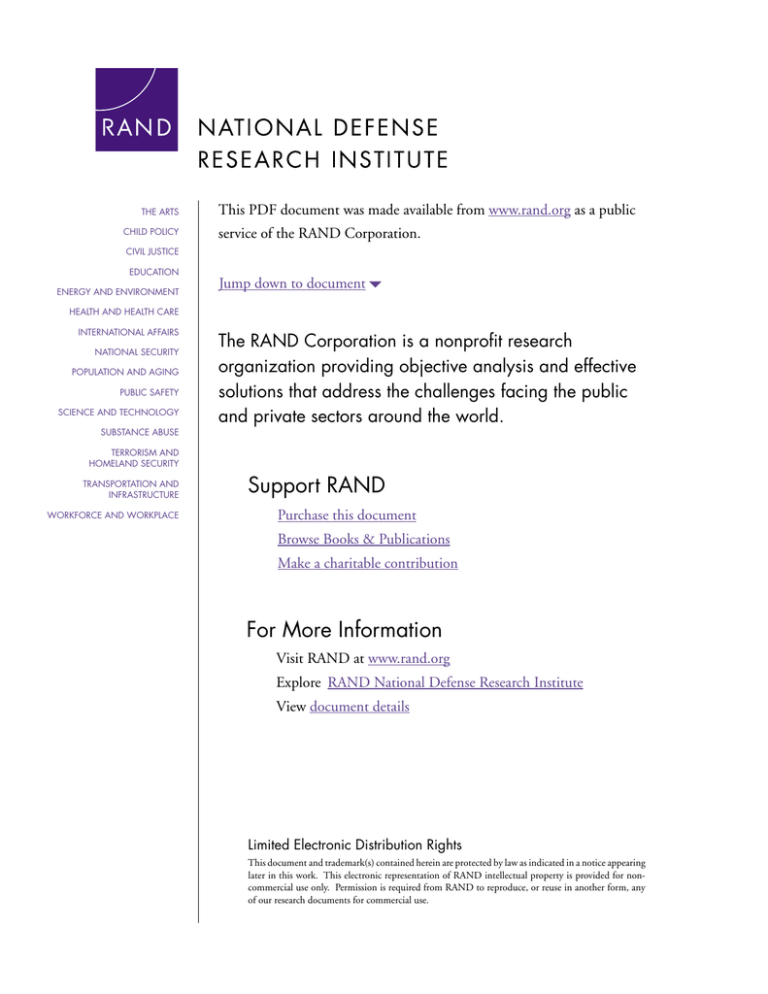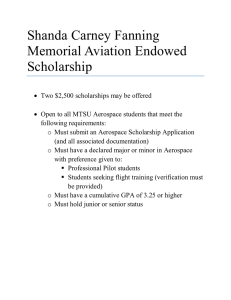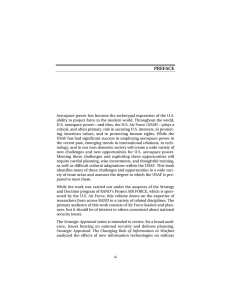6 om as a public service of the RAND Corporation.
advertisement

THE ARTS CHILD POLICY This PDF document was made available from www.rand.org as a public service of the RAND Corporation. CIVIL JUSTICE EDUCATION ENERGY AND ENVIRONMENT Jump down to document6 HEALTH AND HEALTH CARE INTERNATIONAL AFFAIRS NATIONAL SECURITY POPULATION AND AGING PUBLIC SAFETY SCIENCE AND TECHNOLOGY SUBSTANCE ABUSE The RAND Corporation is a nonprofit research organization providing objective analysis and effective solutions that address the challenges facing the public and private sectors around the world. TERRORISM AND HOMELAND SECURITY TRANSPORTATION AND INFRASTRUCTURE WORKFORCE AND WORKPLACE Support RAND Purchase this document Browse Books & Publications Make a charitable contribution For More Information Visit RAND at www.rand.org Explore RAND National Defense Research Institute View document details Limited Electronic Distribution Rights This document and trademark(s) contained herein are protected by law as indicated in a notice appearing later in this work. This electronic representation of RAND intellectual property is provided for noncommercial use only. Permission is required from RAND to reproduce, or reuse in another form, any of our research documents for commercial use. This product is part of the RAND Corporation technical report series. Reports may include research findings on a specific topic that is limited in scope; present discussions of the methodology employed in research; provide literature reviews, survey instruments, modeling exercises, guidelines for practitioners and research professionals, and supporting documentation; or deliver preliminary findings. All RAND reports undergo rigorous peer review to ensure that they meet high standards for research quality and objectivity. Scoping Aerospace Tracking Federal Procurement and R&D Spending in the Aerospace Sector Thor Hogan, Donna Fossum, Dana J. Johnson, Lawrence S. Painter Prepared for the Office of the Secretary of Defense Approved for public release; distribution unlimited The research described in this report was sponsored by the Office of the Secretary of Defense (OSD). The research was conducted in the R AND National Defense Research Institute, a federally funded research and development center supported by the OSD, the Joint Staff, the unified commands, and the defense agencies under Contract DASW01-01-C-0004. Library of Congress Cataloging-in-Publication Data Scoping aerospace : tracking federal procurement and R & D spending in the aerospace sector / Thor Hogan ... [et al.]. p. cm. “TR-263.” Includes bibliographical references. ISBN 0-8330-3856-7 (pbk. : alk. paper) 1. Aerospace engineering—Research—United States—Costs. 2. Space vehicles—United States—Design and construction—Costs. 3. Airplanes—United States—Design and construction—Costs. 4. Government purchasing—United States. I. Hogan, Thor. TL521.S36 2005 629.1072'073—dc22 2005026135 The RAND Corporation is a nonprofit research organization providing objective analysis and effective solutions that address the challenges facing the public and private sectors around the world. RAND’s publications do not necessarily reflect the opinions of its research clients and sponsors. R® is a registered trademark. © Copyright 2005 RAND Corporation All rights reserved. No part of this book may be reproduced in any form by any electronic or mechanical means (including photocopying, recording, or information storage and retrieval) without permission in writing from RAND. Published 2005 by the RAND Corporation 1776 Main Street, P.O. Box 2138, Santa Monica, CA 90407-2138 1200 South Hayes Street, Arlington, VA 22202-5050 201 North Craig Street, Suite 202, Pittsburgh, PA 15213-1516 RAND URL: http://www.rand.org/ To order RAND documents or to obtain additional information, contact Distribution Services: Telephone: (310) 451-7002; Fax: (310) 451-6915; Email: order@rand.org Summary In 2002, the Commission on the Future of the United States Aerospace Industry (Aerospace Commission) approached the RAND Corporation to assist it by scoping the breadth of federal procurement spending on air systems, missile systems, and space systems—including research and development (R&D). This effort was not intended to identify all government aerospace expenditures, but was instead meant to approximate the amount of external (as opposed to internal) federal spending within the aerospace industry.1 RAND presented its findings to the Aerospace Commission in fall 2002; the commission, in turn, used the RAND data in its final report. This follow-on document is intended to explain RAND’s methodology and update and expand upon our initial findings. We chose to use a definition of aerospace industry that was developed by Stanley Weiss and Amir Amir: Assemblage of manufacturing concerns that deal with vehicular flight within and beyond the Earth’s atmosphere. (The term aerospace is derived from the words aeronautics and spaceflight.) The aerospace industry is engaged in the research, development, and manufacture of flight vehicles, including unpowered gliders and sailplanes, lighter-than-air craft, heavier-than-air craft (both fixed-wing and rotarywing), missiles, space launch vehicles, and spacecraft (manned and unmanned). Also included among its concerns are major flight-vehicle subsystems such as propulsion and avionics (aviation electronics) and key support systems necessary for the testing, operation, and maintenance of flight vehicles. In addition, the industry is engaged in the fabrication of nonaerospace products and systems that make use of aerospace technology. 2 With this definition in mind, we analyzed aerospace procurements and R&D expenditures within three subsectors: air systems, missile systems, and space systems. This analysis looked at eleven years (1993–2003) of data gleaned from the Federal Procurement Data System. Our intent was to provide a picture of recent trends in external federal aerospace spending, as requested by the Aerospace Commission. Our study revealed a clear downward trend in federal aerospace procurement and R&D expenditures during the past decade. 3 The analysis suggests that this decline was felt in ____________ 1 The results only approximate external spending because they do not include classified military programs, which could not be identified using the Federal Procurement Data System (the database utilized for this study). 2 Stanley I. Weiss and Amir R. Amir, “Aerospace Industry,” available at Encyclopedia Britannica Online, accessed 19 July 2004. 3 This general trend includes spending by the two major aerospace agencies (DoD and NASA) as well as smaller actors such as FAA, DOT, NOAA, and GSA. xi xii Scoping Aerospace: Tracking Federal Procurement and R&D Spending in the Aerospace Sector each of the primary aerospace sectors—air systems, missile systems, and space systems. Overall, air system spending fell 35 percent and missile system spending fell 50 percent. Space system expenditures dropped by a somewhat lower amount—10 percent. We found some evidence that this trend may be reversing itself—specifically, a large increase in Department of Defense (DoD) spending in 2003. This was most likely caused by a change in presidential administrations and regular military procurement cycles (particularly with relation to air systems); however, the turnaround did not become evident until 2003 because of a typical lag between budgeting and actual spending. Our examination revealed a potentially worrisome trend in military airframe procurements, which had declined by 50 percent before a one-year spike in 2003. 4 This decrease in spending could be explained by regular procurements cycles and federal budgetary priorities, but such a sharp drop suggests that military expenditures may remain far below Cold War–era levels. Full air system procurements (which include engines, components, and infrastructure) also dropped during the period studied, although not as steeply as did airframe spending. One possible reason for this slower decline could be that the military has had to maintain some spending for engines and major air system components as it attempts to field an ever-smaller number of operational airframes. One potential outcome, if airframe procurements do not fully recover, is that engine and major component expenditures may eventually decrease as the military transitions to a smaller suite of air assets. We also found that overall DoD aerospace-related R&D spending dropped dramatically after the Cold War—these expenditures were cut in half during the period studied. Overall, external military spending (for air systems, missile systems, space systems, and aerospace R&D) declined by over 40 percent during the period examined. Our findings regarding the National Aeronautics and Space Administration (NASA) are only slightly more favorable. The agency has seen a 35 percent decline in its external spending during the past decade. It has been able to maintain its level of space system expenditures during this period (they decreased by only 10 percent), but many other areas have suffered. Our data reveal three ways that NASA has maintained most of its programcentric spending: drastically reducing infrastructure expenditures, increasing its dependence on technical service providers, and cutting R&D spending by over 40 percent during the past decade. These findings reveal that NASA’s leaders have made hard decisions (e.g., deferring critical infrastructure repairs) to maintain a relatively aggressive slate of mission priorities while the agency’s real buying power has been falling. The question that remains, however, is whether these strategies can be maintained indefinitely. ____________ 4 DoD figures do not include all “black” (classified) aerospace programs.






